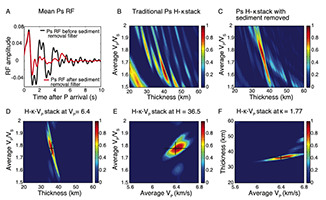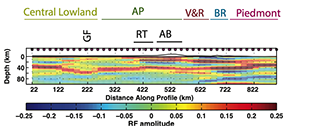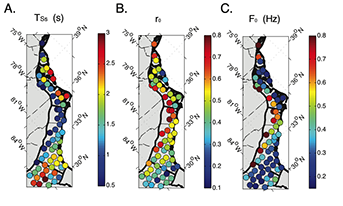

The southeastern United States (SEUS) has a rich tectonic history of inherited structures and ongoing seismicity

Synthetic example of H-k-VP stacking of receiver functions from Cunningham and Lekic (2019) shows improved constraints from removing sediment reverberations

Common Conversion Point (CCP) stacks of receiver functions help to image "cross-sections" of the crust and lithosphere beneath the SEUS

High frequency receiver functions help to constrain properties Atlantic Coastal Plain sediments from Cunningham and Lekic (submitted to BSSA)
My current research has focused on constraining the sediment and crustal structure of the southeastern United States using converted seismic waves (receiver functions)
Tectonic plates glide across the underlying mantle, shaping the history of our continents through collision and subduction. These plates make up the lithosphere, the Earth’s topmost layer that includes the crust and rigid upper portion of the mantle. As continents collide and break apart making new continents and creating new tectonic plates, the lithosphere is deformed. Lithospheric structure then contains a history of the continental formation and evolution of a region as well as provides evidence for ongoing mantle dynamics. Observed variations in the lithospheric structure are often used to understand tectonic processes: thinned lithosphere implies extensional or rifting forces are at play, while thickened lithosphere implies compressional or collisional forces.
The southeastern United States (SEUS) has undergone multiple episodes of continental convergence and rifting, so mapping the boundaries of accreted terrains from previous collisional events – or inherited structures – can clarify the tectonic history of this region. Boundaries between inherited structures may also correlate with the ongoing seismicity of the region. Being distant from the nearest tectonic plate boundary, the damaging earthquakes observed in the SEUS cannot be explained by release of energy accumulated between plates moving with respect to one another. The long recurrence time of large intra-plate earthquakes makes them particularly dangerous and the location and magnitude of these events are difficult to predict. Mechanisms controlling the location of intra-plate seismicity are poorly understood, but are likely related to preexisting zones of weaknesses in the crust or lithosphere inherited from past tectonic history of the SEUS.
A common seismological tool for imaging boundaries beneath the surface is receiver functions. Receiver functions are sensitive to discontinuities from differences in material properties such as the basin-bedrock interface, the crust-mantle boundary (often referred to as the Moho) and the lithosphere-asthenosphere boundary (LAB). The basin-bedrock boundary is important for understanding the long-period (low frequency) effects of shaking during an earthquake, which affects large buildings and structures. The largest ground motions are related to the depth and contrast between the basin-bedrock interface, and so constraining this across the SEUS will have implications for hazard analysis.
Constraining crust and Moho properties across the SEUS using receiver functions may help to understand the history of inherited structures and seismicity. Sharp changes in the Moho boundary may correlate with regions of seismicity or indicate locations of inherited crust; while the thickness and structure of the lithosphere in the SEUS is still debated, and further constraints might clarify the depth extent of the plate boundary. Variations in the LAB and other intra-lithospheric discontinuities may also be weak-zones related to inherited structures that correlate with seismicity. Currently, hazard estimates of intra-plate earthquakes use the ongoing seismicity in the area. These hazard assessments likely overestimate the hazard in regions with small seismicity and simultaneously underestimate the hazard in regions that have may have the potential to produce large earthquakes but haven’t in the historic past (Stein and Liu, 2009). By better understanding how lithospheric variations relate to currently active regions of seismicity, we may be able to predict locations of large and damaging intra-plate earthquakes in the future.
Although it is one of the more straightforward methods to studying lithospheric discontinuities, calculating receiver functions in the SEUS has proven difficult. Atlantic Coastal Plain sediments overlie the majority of the SEUS, and signal from sedimentary basins can overprint signals from deeper earth structure. Therefore, in my dissertation research, I first developed a method to constrain the crust/mantle boundary in regions with sedimentary basins (H-k-VP stacking), and then I constrain important basin/bedrock properties for hazard analysis in the SEUS. Finally, I apply the new methodologies to the SEUS to investigate the underlying lithosphere without sediment contamination. This work has implications for improving characterization of lithospheric structure beneath regions with sediment, which may be up to 70% of the continental United States.
Erin Cunningham
ecunnin2@umd.edu